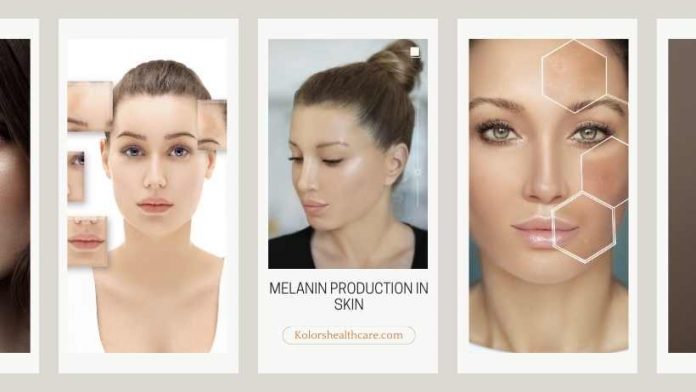Melanin comes in various forms and fulfills an assortment of biological functions, including hair and skin pigmentation. It is also involved in photoprotection of the eye and skin. The accumulation of melanin, containing melanosomes, in the epidermis’s basal layer, determines the skin’s pigmentation.
Melanin is also important because it is a UV-absorbing agent. It can protect the skin from the harmful effects of UV light. And also safeguards the skin from UVB and blue light.
Melanin plays a crucial role in determining the pigmentation levels of hair. Eumelanin is a type of melanin. An abundance of eumelanin gives brown or black hair. Another type, known as pheomelanin, in abundance, gives you red hair.
Understanding Melanin and its Role In the Skin
Scientists have identified three types of melanin in humans. These are –
- Eumelanin
- Pheomelanin
- Neuromelanin
The epidermis layer of the skin contains eumelanin and pheomelanin. Neuromelanin, by contrast, is only present in the brain.
Melanocytes are the cells that harvest both eumelanin and pheomelanin. Subsequently, cells called keratinocytes are involved in carrying melanin to the skin’s surface.
Melanocytes produce more melanin in people with dark skin when compared to those with light skin tones.
There is a medley of biological functions performed by melanin. These include –
- Pigmentation of the hair
- Pigmentation of the skin
- Protection of the skin and eyes from sunlight
Melanocytes harvest melanin within the basal layer. Epidermis consists of various layers, and this is the deepest. In the end, keratinocytes carry melanin to the surface of the skin.
This results in differences in skin color among people. It is due to the ratio of eumelanin to pheomelanin. And the count of melanocytes as well.
The pinkish color of the lips, nipples, vagina, and penis glans is because of pheomelanin. And the difference in colours of hair results from the disparate distribution of varied types of melanin.
Factors Affecting Melanin Production
The extent of melanin in the skin will differ from one person to another. And genetics plays a crucial role in determining the amount of melanin present in an individual’s skin.
Melanocytes, called melanosomes, contain melanin within cells. And that the amount of melanin in the skin is of good quantity and evenly distributed.
It is important to note that skin pigmentation differences are due to the number of melanocytes in the skin. And also due to the ratio of eumelanin to pheomelanin.
People with light skin typically have melanocytes with melanosome clusters of two or three types. And in contrast, people with dark skin usually have individual melanosomes that can also rapidly produce melanin for keratinocytes.
Other factors that affect the level of melanin in the skin include the following:
- Age of the individual
- Exposure to UV light
- Extent of inflammation
- Changes in levels of hormones
Natural Methods to Increase Melanin Production
There are many ways to increase melanin production in your body naturally. Nutrients are a key factor in increasing melanin in the skin uniformly. Here is a short list of a few nutrients that can help your body produce more melanin.
1. Antioxidants
They have the most substantial potential for increasing the production of melanin. Micronutrients like polyphenols or flavonoids come from the plants that we eat. And they act as powerful antioxidants, which eventually affect melanin production. So, eat more foods rich in antioxidants, including dark berries, dark chocolate, dark leafy greens, and colorful vegetables. Taking mineral and vitamin supplements can also be helpful.
2. Vitamin A
It is vital to the production of melanin. This vitamin is also essential for maintaining healthy skin. Vitamin A can be obtained from the food you eat. It is primarily available from vegetables that contain beta-carotene. These include vegetables like carrots, peas, spinach, and sweet potatoes. However, more research is required to prove that vitamin A increases melanin production in people.
3. Vitamin E
This is yet another essential vitamin for skin health. Vitamin E is also an antioxidant and could boost melanin levels in the body. However, no studies have proven a direct link between vitamin E and more melanin. Although some studies show, vitamin E will likely help protect skin against damage from sunlight. Vitamin E can be taken as supplements. Or consume more vitamin-rich foods like grains, nuts, seeds, and vegetables.
4. Vitamin C
This vitamin, like others, is also an antioxidant. It is required for the formation of healthy mucous membranes. Vitamin C also has some impact on the production of melanin and the protection of the skin. Foods rich in vitamin C include berries, citrus, and leafy green vegetables. Consuming vitamin C supplements are also helpful.
5. Herbs and Botanicals
The potential benefits of herbs, teas, and essential oils for protecting skin against UV rays have been widely explored. Herbs like green tea and turmeric, rich in polyphenols and flavonoids, help protect the skin. They can skulk reactive oxygen species and prevent UV irradiation as well. However, herbs and botanicals may not help increase melanin production.
Lifestyle Practices for Healthy Production of Melanin
Lifestyle changes can help us generate healthy hair and skin instead of costly therapies. A lack of proper diet will keep us yearning for skin free of pigmentation. And undesired melanin concentration will make things worse.
Topical aids will only act as a temporary fix for beauty. The real deal comes from what you eat or avoid eating. A proper diet can be a resourceful aid in tackling issues associated with hyperpigmentation.
Top 10 Foods that Help in the Production of Melanin
- Carrots: Rich in beta-carotene, helps in maintaining melanin production
- Cheese: Contains vitamins like B12 and D, contributes to healthy hair and skin.
- Chia Seeds: Packed with omega-3 fatty acids, promote healthy hair follicles
- Eggs: High in protein, biotin, and essential nutrients, building blocks for melanin synthesis
- Ginger: Antioxidant properties, helps in preserving melanocytes, the cells that produce melanin
- Oatmeal: Rich in nutrients like zinc, iron, and copper, oatmeal, supports melanin production
- Pumpkin: Contains carotenoids, which are converted to vitamin A in the body
- Milk: Nutrients like calcium, protein, and vitamin D, important for melanin synthesis
- Tomatoes: Contain antioxidants like lycopene, protect skin from oxidative stress, and maintain melanin levels
- Yogurt: High in vitamin B5, helps support melanin production
Diet is the most essential way to regain skin health. It ensures a nutritional balance that allows glowing skin to radiate from within. And a blemish-free skin complexion ups your confidence and self-esteem. This is why you must be careful about what you are eating.
Seeking Professional Advice – Kolors Healthcare
Feel free to ask skin specialists and dermatologists at Kolors. Please book an appointment with our specialists or call to visit our clinic near you.









